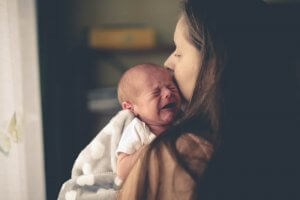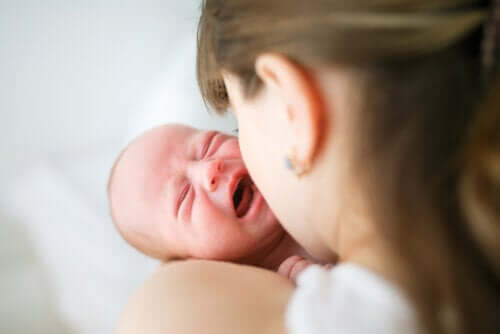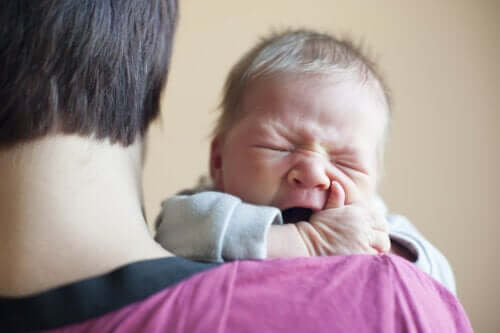Child Abuse and Shaken Baby Syndrome

Shaken baby syndrome is one of the most frequent forms of child mistreatment. It involves lesions to the brain that result from the shaking of a baby while holding its thorax. It’s an indicator of physical violence towards children and can produce serious consequences, including death.
In the following article, we’ll provide further information about this syndrome.
What is shaken baby syndrome?
Shaken baby syndrome refers to a series of brain lesions that occur when a child has been shaken violently. It’s an indicator that the child has gone through physical mistreatment. The injuries occur because the neck musculature of babies hasn’t developed sufficiently yet. In other words, they have a hard time holding their heads up.
It’s important to keep in mind that an adult’s strength and the difference in size can be enough to cause damage to small children… even if it’s not the caretaker’s intention to cause harm.
What occurs is that, by shaking a child violently, their head moves uncontrollably in all different directions. This causes the baby’s brain to crash against the hard bones of the surrounding cranium.

This impact produces damage to the baby’s neurons or, in other words, the cells of the brain. This damage may be reversible or irreversible. It can also cause brain hemorrhaging and injury to the eyes. Finally, shaking a baby can even lead to death.
Symptoms
Some of the symptoms that can appear in babies that have been subject to violent shaking are:
- Nervousness or agitation.
- Sleepiness.
- Irritability.
- Rejection towards food, vomiting, nausea…
- Difficulty breathing.
- Convulsions.
- Blindness.
- Paralysis.
- Coma, in the most serious cases.
It’s possible not to observe any symptoms immediately after an injury has occurred. However, when the damage is sufficiently serious, then the symptoms we mentioned above will begin to appear within several hours… if not sooner.
You may also want to read: Psychological Abuse in Children and Its Consequences
What are the consequences of shaken baby syndrome?
One in every 10 children who suffer from this type of brain injury end up dying. Of those that survive, up to 50% end up with serious and irreversible damage. Some of the consequences can be blindness, cerebral palsy, intellectual disability, epilepsy, difficulties with language, etc.

How to prevent shaken baby syndrome?
If there are other people that help in the care of your baby, make sure they understand the seriousness of this type of injury. At the same time, if you suspect your baby may be suffering abuse of any type, seek help and take action.
On occasion, babies cry for long periods of time and for no apparent reason. It’s easy for parents to become overwhelmed and feel like they’re going to lose their cool. However, you need to always keep in mind how dangerous this can be. Remember the consequences that it can be when an adult caretaker acts impulsively with a baby.
There are training courses that can help parents understand why their children are crying. What’s more, these courses help parents know how to react. If you’re a parent or caretaker and have a hard time controlling your emotions at times, don’t hesitate to reach out for expert help.
You may also want to read: Children’s Rights According to UNICEF
Conclusion…
Never forget how fragile babies are! Parents and caretakers need to be especially careful with them and pay attention to any sign of mistreatment. If you suspect child abuse or have a hard time managing your emotions around a child, seek professional help.
Shaken baby syndrome is one of the most frequent forms of child mistreatment. It involves lesions to the brain that result from the shaking of a baby while holding its thorax. It’s an indicator of physical violence towards children and can produce serious consequences, including death.
In the following article, we’ll provide further information about this syndrome.
What is shaken baby syndrome?
Shaken baby syndrome refers to a series of brain lesions that occur when a child has been shaken violently. It’s an indicator that the child has gone through physical mistreatment. The injuries occur because the neck musculature of babies hasn’t developed sufficiently yet. In other words, they have a hard time holding their heads up.
It’s important to keep in mind that an adult’s strength and the difference in size can be enough to cause damage to small children… even if it’s not the caretaker’s intention to cause harm.
What occurs is that, by shaking a child violently, their head moves uncontrollably in all different directions. This causes the baby’s brain to crash against the hard bones of the surrounding cranium.

This impact produces damage to the baby’s neurons or, in other words, the cells of the brain. This damage may be reversible or irreversible. It can also cause brain hemorrhaging and injury to the eyes. Finally, shaking a baby can even lead to death.
Symptoms
Some of the symptoms that can appear in babies that have been subject to violent shaking are:
- Nervousness or agitation.
- Sleepiness.
- Irritability.
- Rejection towards food, vomiting, nausea…
- Difficulty breathing.
- Convulsions.
- Blindness.
- Paralysis.
- Coma, in the most serious cases.
It’s possible not to observe any symptoms immediately after an injury has occurred. However, when the damage is sufficiently serious, then the symptoms we mentioned above will begin to appear within several hours… if not sooner.
You may also want to read: Psychological Abuse in Children and Its Consequences
What are the consequences of shaken baby syndrome?
One in every 10 children who suffer from this type of brain injury end up dying. Of those that survive, up to 50% end up with serious and irreversible damage. Some of the consequences can be blindness, cerebral palsy, intellectual disability, epilepsy, difficulties with language, etc.

How to prevent shaken baby syndrome?
If there are other people that help in the care of your baby, make sure they understand the seriousness of this type of injury. At the same time, if you suspect your baby may be suffering abuse of any type, seek help and take action.
On occasion, babies cry for long periods of time and for no apparent reason. It’s easy for parents to become overwhelmed and feel like they’re going to lose their cool. However, you need to always keep in mind how dangerous this can be. Remember the consequences that it can be when an adult caretaker acts impulsively with a baby.
There are training courses that can help parents understand why their children are crying. What’s more, these courses help parents know how to react. If you’re a parent or caretaker and have a hard time controlling your emotions at times, don’t hesitate to reach out for expert help.
You may also want to read: Children’s Rights According to UNICEF
Conclusion…
Never forget how fragile babies are! Parents and caretakers need to be especially careful with them and pay attention to any sign of mistreatment. If you suspect child abuse or have a hard time managing your emotions around a child, seek professional help.
All cited sources were thoroughly reviewed by our team to ensure their quality, reliability, currency, and validity. The bibliography of this article was considered reliable and of academic or scientific accuracy.
- Síndrome del niño zarandeado | EnFamilia [Internet]. [cited 2020 Feb 7]. Available from: https://enfamilia.aeped.es/prevencion/sindrome-nino-zarandeado
- Síndrome del niño zarandeado: Lo que todos deberíamos saber | Familia y Salud [Internet]. [cited 2020 Feb 7]. Available from: https://www.familiaysalud.es/podemos-prevenir/prevencion-de-accidentes/como-prevenir/sindrome-del-nino-zarandeado-lo-que-todos
- Síndrome del niño zarandeado | Asociación Española de Pediatría [Internet]. [cited 2020 Feb 7]. Available from: https://www.aeped.es/rss/en-familia/sindrome-nino-zarandeado
- García JLJDJA. Síndrome del niño zarandeado [Internet]. 2003 [cited 2020 Feb 7]. Available from: http://www.fapmi.es
This text is provided for informational purposes only and does not replace consultation with a professional. If in doubt, consult your specialist.








